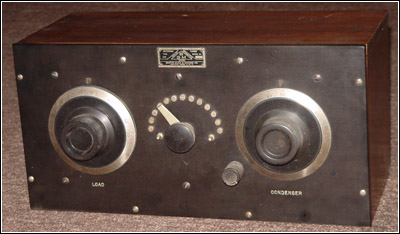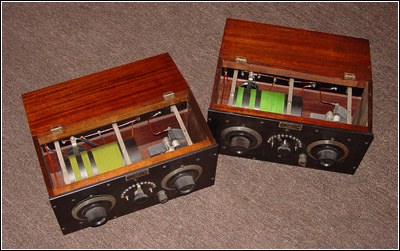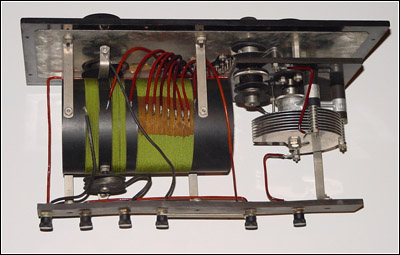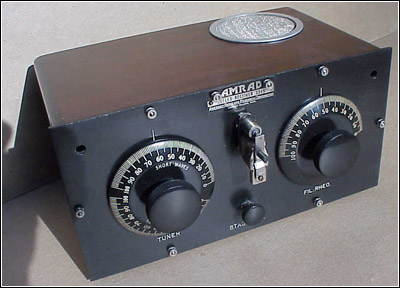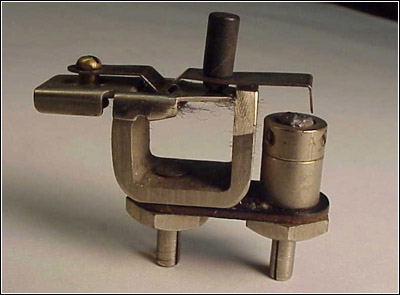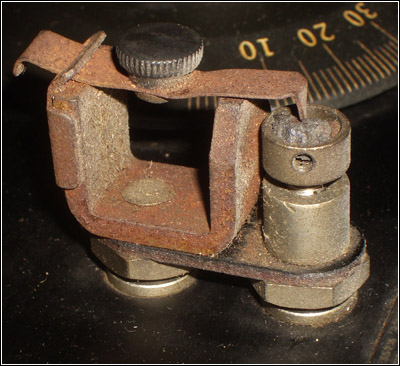Of Old Radios And Related Items--Published Monthly
Boston Scale & Machine Co.
Type 105 Receiving Tunerby Alan Douglas
WEB EDITION
In the name of preservation, one collector loans a set to another as a model for a set in dire need of restoration. Alan Douglas describes the happy results of such a collaboration. (Editor)
When Richard Foster dropped by this morning to return my Boston Scale & Machine tuner, which he had borrowed as a model to restore his set, shown in Figure 1, I couldn't resist snapping a photo of the two side by side. I couldn't tell which was which. See Figure 2. When he got his set, it was missing the entire coil assembly, the back panel, and other mechanical parts. It also had a hole in the panel. Evidently someone had converted it to short waves around 1930.
These tuners, and the companion Type 100 detector-amplifier, turn up in the Boston area from time to time, but I have never seen any advertising, or any mention of the parent company. They are presumably from 1922, when the broadcasting boom began.
Boston Scale spared no expense in designing these sets, using some pretty elaborate metal work. The coil rotor and tuning capacitor, as examples, have heavy spiral pigtail connections kept from tangling by metal disks on either side. See Figure 3. Most of the fabricated parts are unlike those of other makers; for instance, when Richard recreated the binding posts, he had to turn them from hex brass stock and nickel-plate them. The dials seem to be unique too, with black and silver metal skirts. And note the real wood inlay banding on the cabinet in Figure 4 (see print version). Figure 5 shows the label on the tuner (see print version).
Figure 1. A Boston Scale & Machine Co. Type 105 receiving tuner restored by Richard Foster.
Figure 2. Side by side, Alan Douglas's Boston Scale & Machine Co. Type 105 receiving tuner and the set restored by Richard Foster. Alan couldn't tell the difference can you?
Figure 3. An interior view of Richard Foster's restored set showing the heavy spiral pigtail connections kept from tangling by metal disks on either side.Did Boston Scale & Machine Co. return to making scales after testing the wireless waters? I don't know.
(Alan Douglas, an electrical engineer, has been interested in old radios since the age of ten. His extensive collection includes a library of 5,000 radio-related books and magazines, now occupying a special addition to his house. He has written well over 100 articles and papers for radio and engineering publications. His books, "Radio Manufacturers of the 1920s, Volumes I, II, and III" are highly regarded resources for radio collectors.)
Amrad Model 3366 and Its Crystal Detector
By Dave Crocker
Web Edition
Dave Crocker describes his unexpected reward for helping a friend. The moral of the story: never pass up an attic-cleaning project. (Editor)
A West Coast friend visiting here on the Cape called on me to help him empty out his family home, as it was going up for sale. It seems his father and grandfather had been "pack-rats" and the grand old Greek Revival residence was full of items that needed to be sorted out.
In particular, virtually tons of literature consisting of old newspapers, magazines and well over 3,500 books had been stored in the attic and upper attic since 1896. The magazines, Life and other forgotten titles, were piled up in the upper attic, whose access was with a ladder through an opening in the ceiling. My friend passed down the hundreds of old magazines to me on the ladder. Part way through the process he reached behind the piles of magazines and said: "You like old radio stuff here's something you might be interested in. It's some kind of 'tuner' want it?"
Figure 1. The Amrad Model 3366 reflex receiver with a crystal detector.I blew the dust off of it and saw it was an old cardboard box, of which only part of the cover had been opened. Under it I saw the word "Tuner" and that was enough for me. I didn't open it until I got home. It was then I almost fell over, as inside the (factory) box was the most pristine Amrad Model 3366 radio I had ever seen. It had never been used! A few days later I took it apart and studied the insides perfect!
The Amrad Model 3366, shown in Figure 1, was marketed in 1922 by the American Radio and Research Corporation of Medford Hillside, near Boston, Massachusetts. It is a 1-tube receiver with a unique magnetic crystal detector designed by Amrad's own woman engineer, Eunice Randall. The detector had a metal pointer held to the crystal mineral by a permanent magnet, as shown in Figures 2 and 3 (see print version). These detectors were plug-in units, having two prongs for removal. On the top of the cabinet, the tube opening had a round, aluminum cover with fine mesh screening to observe the filament and release any heat that might accumulate.
Now, over the years I have seen more than a few of these Amrad crystal-reflex sets, and have taken notice of the ones pictured in antique radio magazines and just about all of them have had some modifications to their detectors by their owners. Many years ago, someone even fabricated reproduction detectors, which were almost, but not exact, and the few produced were quickly grabbed-up by radio restorers. I managed to buy the last one made myself. It seems that the original detector units were either lost or were replaced with Amrad's other non-magnetic detector over the years. It, too, was a plug-in type.
Figure 2. The detector's metal pointer is held to the crystal mineral by a permanent magnet.Knowing that the detector on my Model 3366 was about as accurate as you can get, I thought it would be interesting to those who have Amrad magnetic detector sets to compare theirs with mine. It appears that Amrad may have made some production changes that include the elimination of the small holding screw. Notice the rather thin Bakelite handle for adjusting the pointer. These handles have usually been replaced by a dry cell battery cap or something similar. Also, notice in Figure 3 the tiny brass screw that holds the pointer strip to the unit, so it won't be lost. However, this minute screw and nut were easily lost as well.
Dave Crocker, a graphic artist and semi-retired member of the A.R.C. staff, has been collecting radios for over 30 years. Many of those years have been spent researching and collecting radios made by the Crosley Radio Company.
Another Amrad Detector
Contributed by John V. Terrey
Responding to Dave Crocker's inquiry about other Amrad crystal detector designs, I offer this one. I have two Amrad Model 3366 sets, each obtained from a different source and both have this detector style. I assume that the "original rust" might somewhat authenticate it as original.
|
[Free Sample] [Books, etc., For Sale] [Subscribe to A.R.C./Renew] [Classified Ads] [Auction Prices] [Event Calendar] [Links] [Home] [Issue Archives] [Book Reviews] [Subscription Information] [A.R.C. FAQ]URL = http://www.antiqueradio.com/Mar09_Douglas_BostonScale.html Copyright © 1996-2009 by John V. Terrey - For personal use only. Last revised: February 28, 2009. For Customer Assistance please contact ARC@antiqueradio.com or call (866) 371-0512 toll free Pages designed/maintained by Wayward Fluffy Publications Antique Radio Classified |
